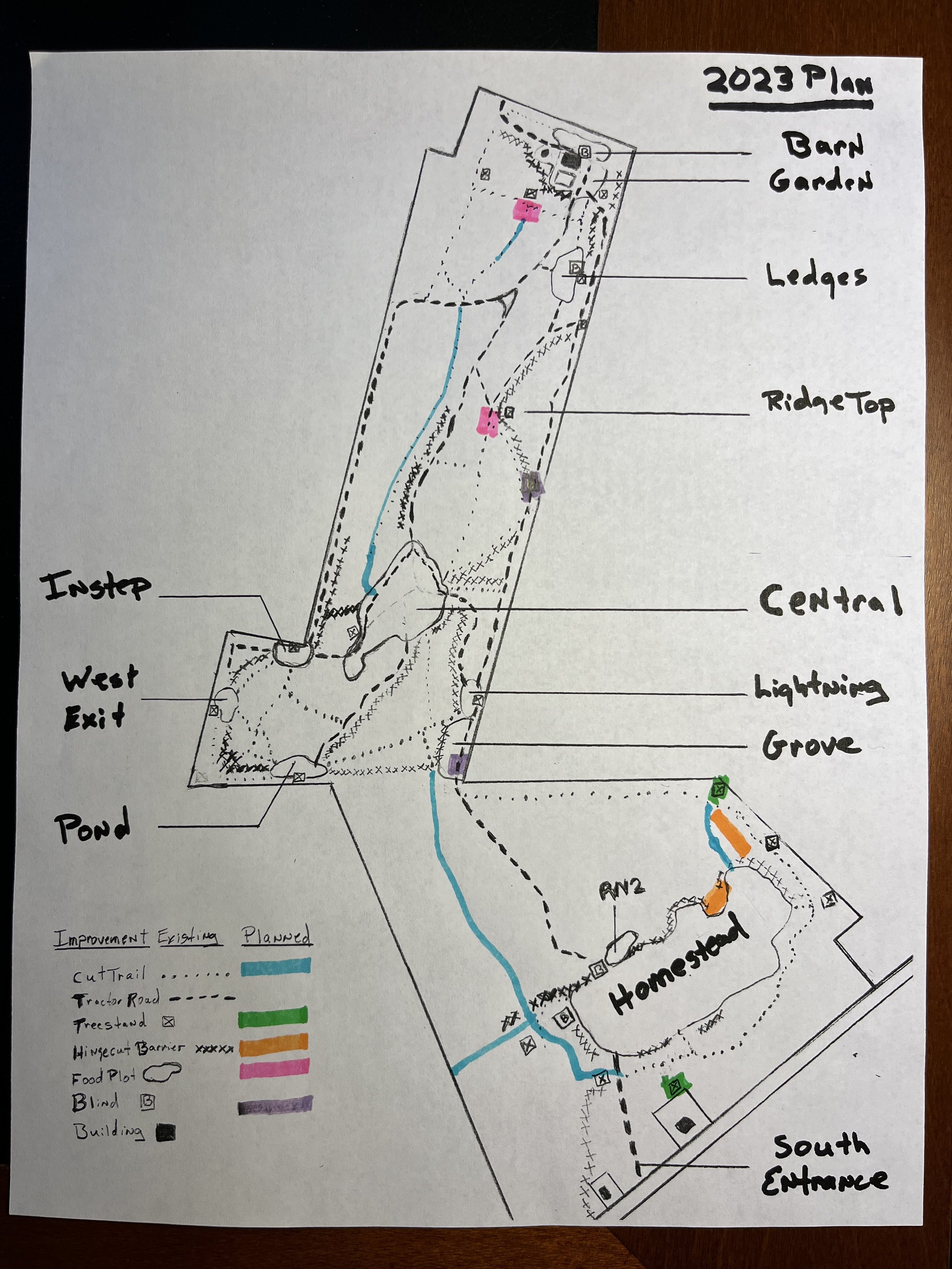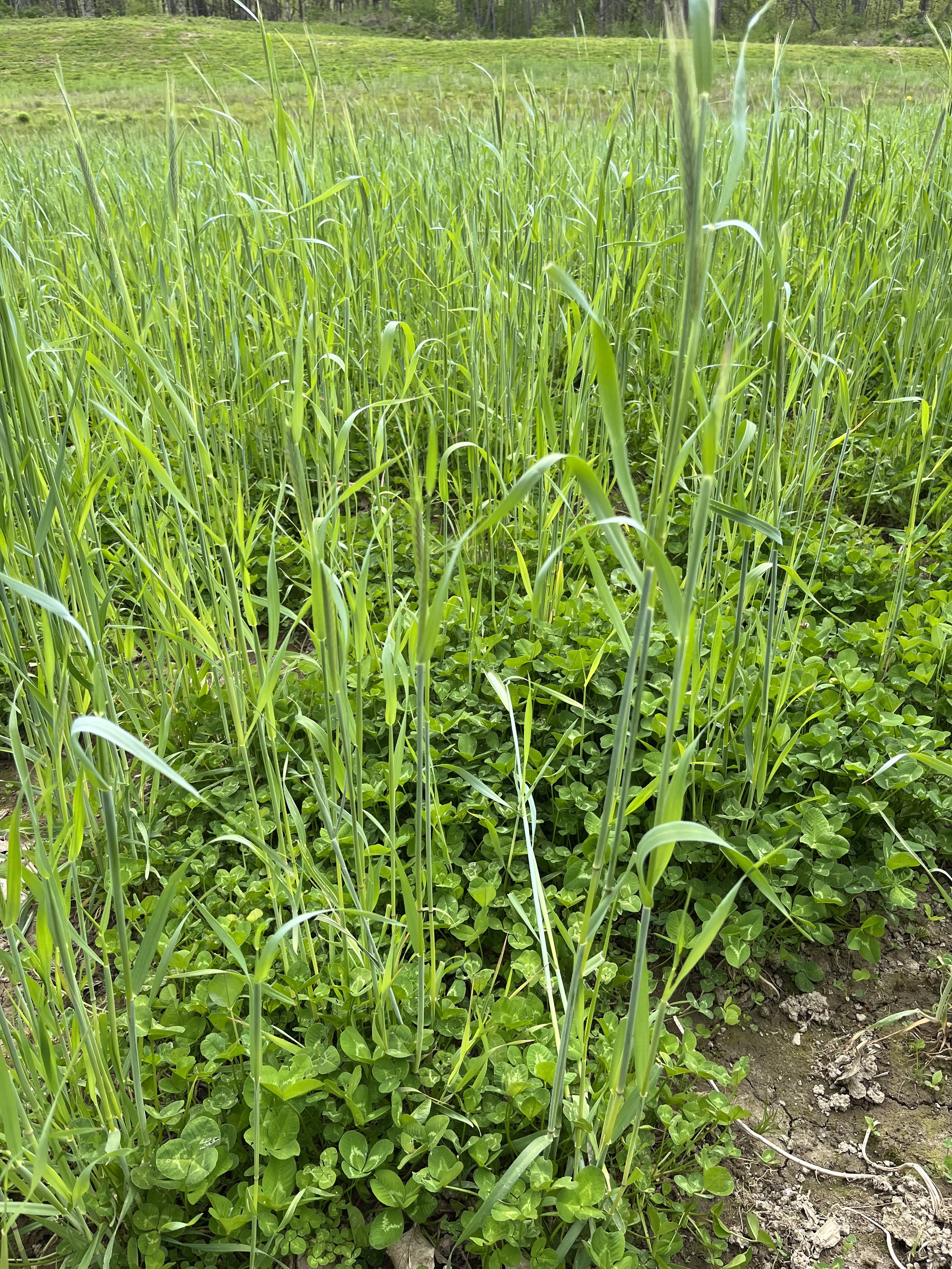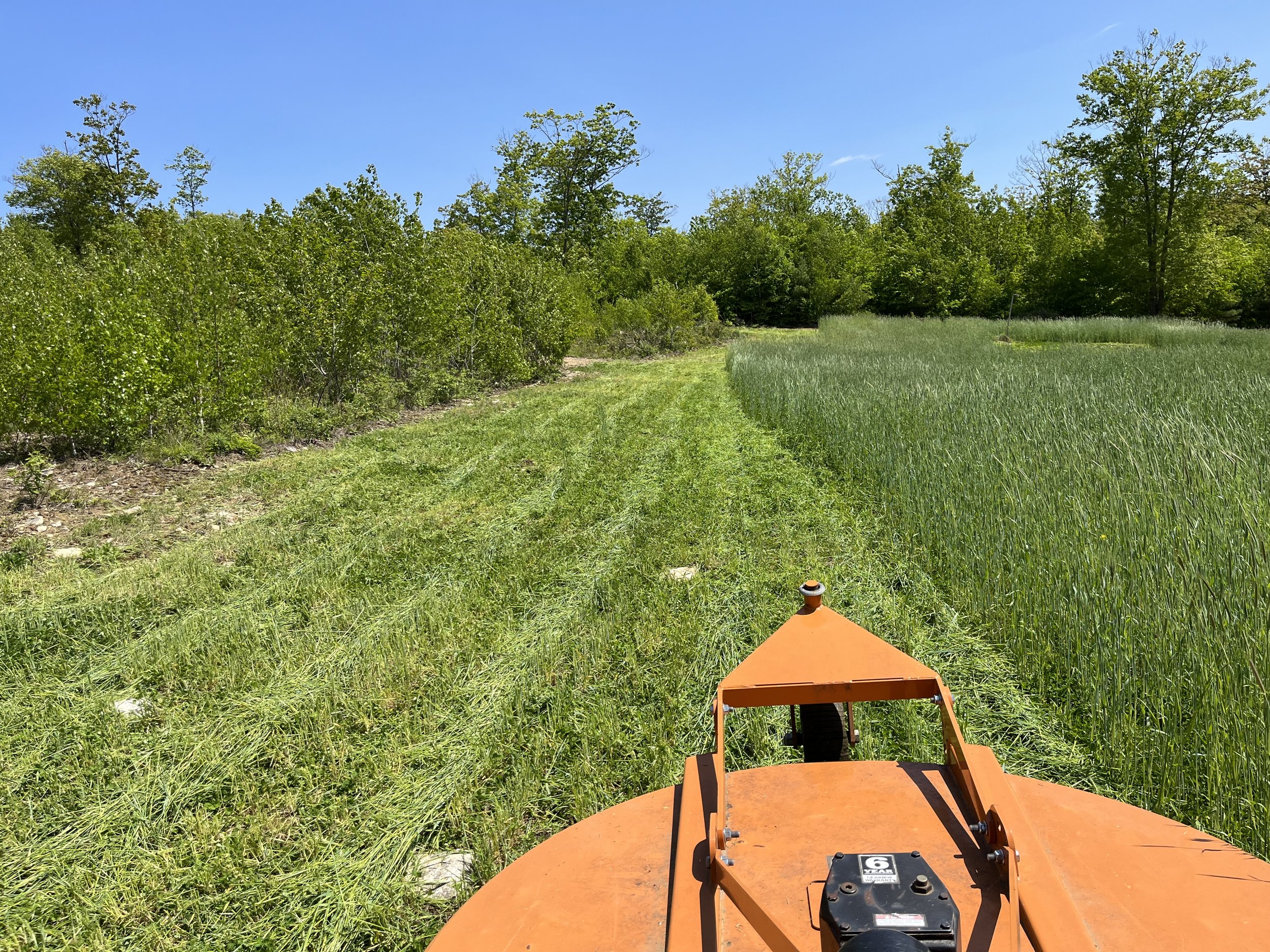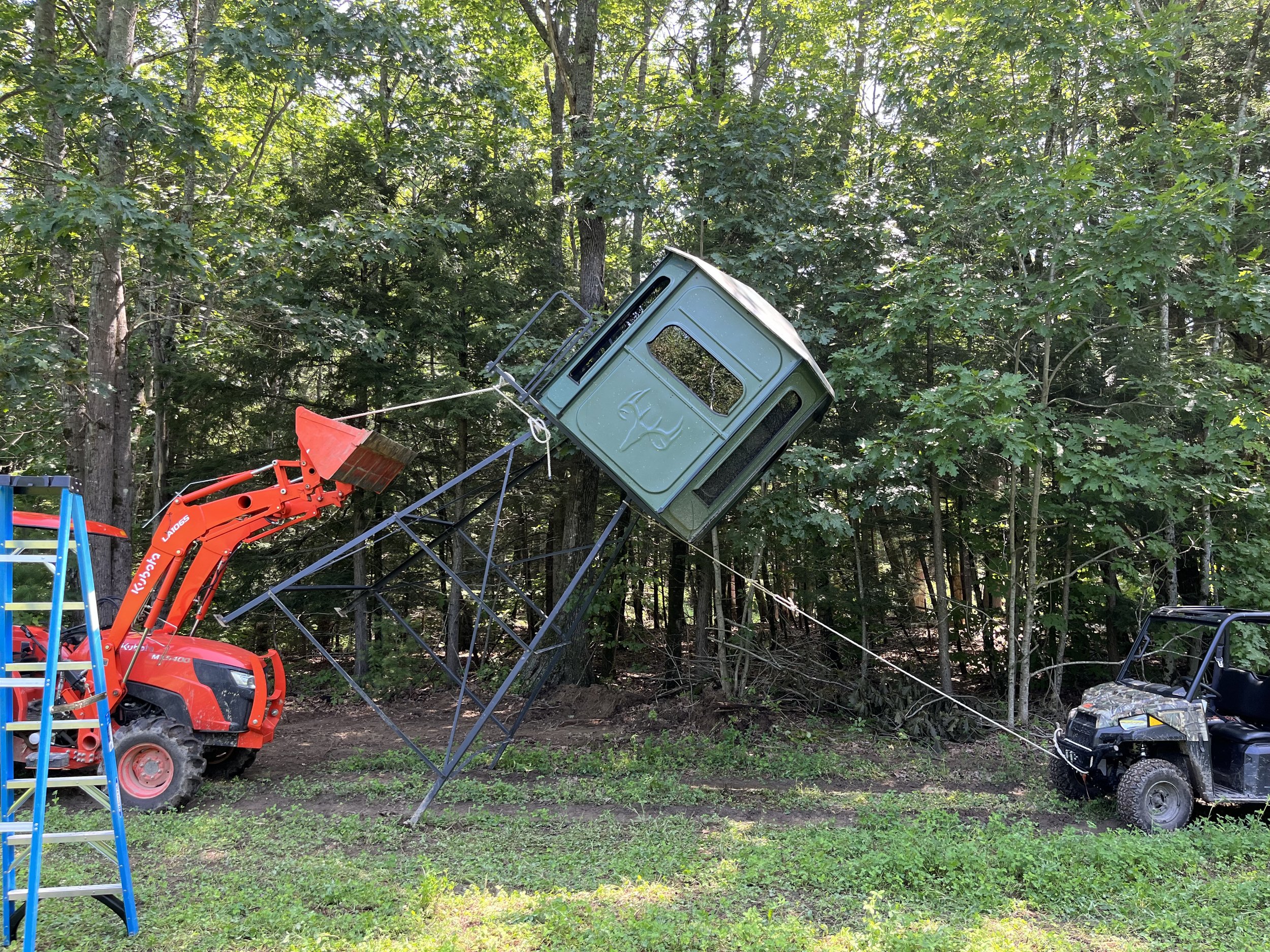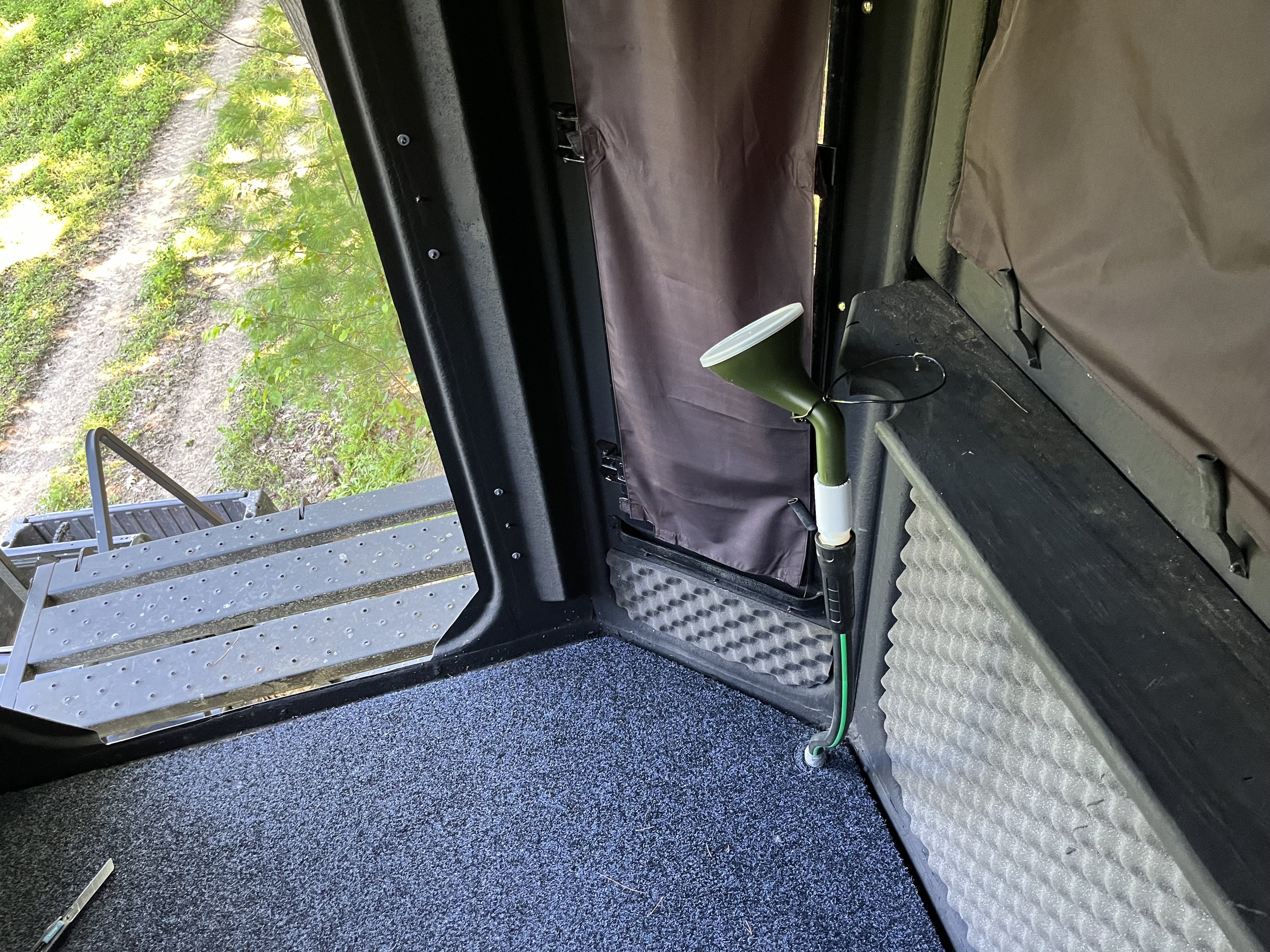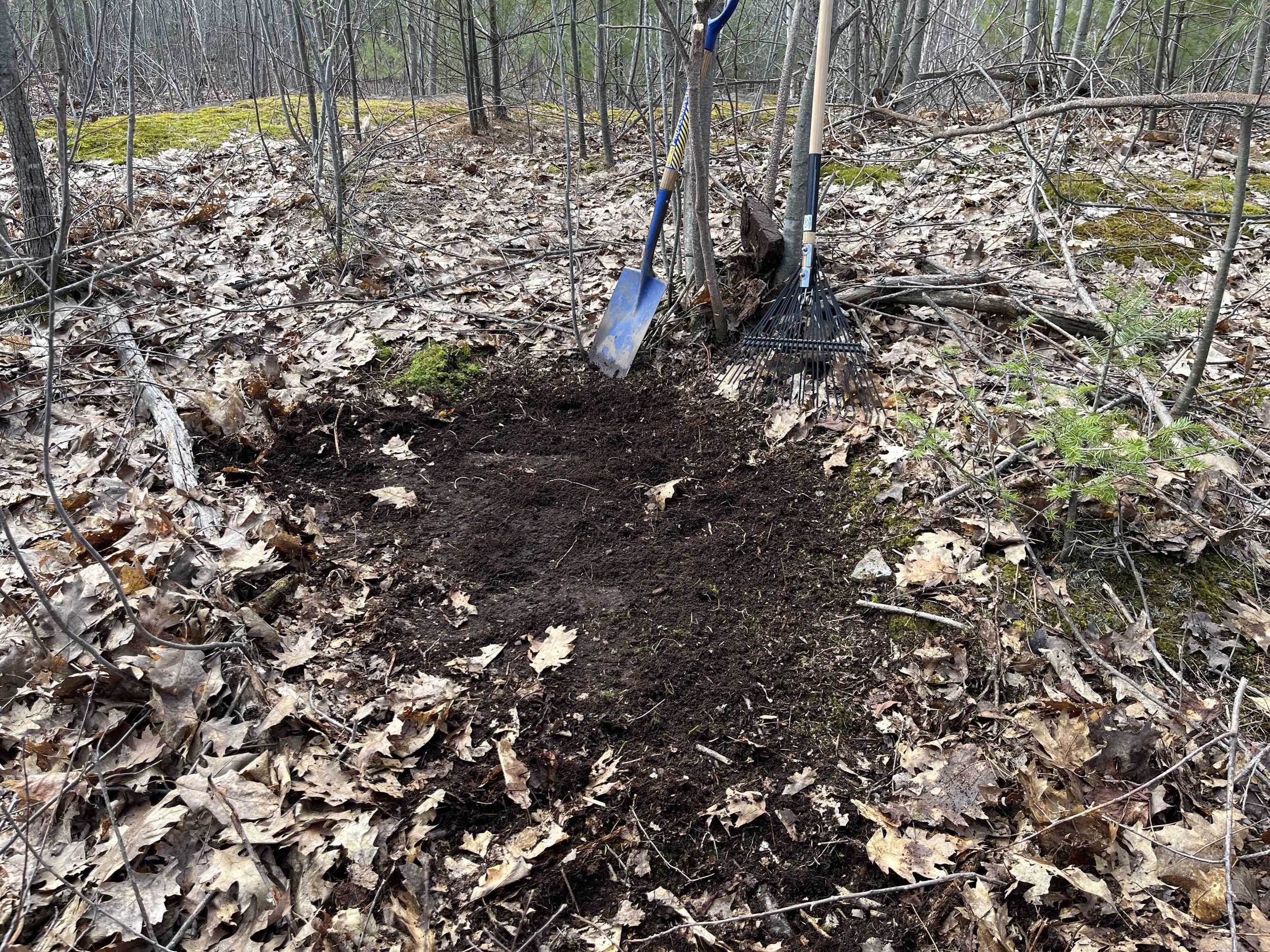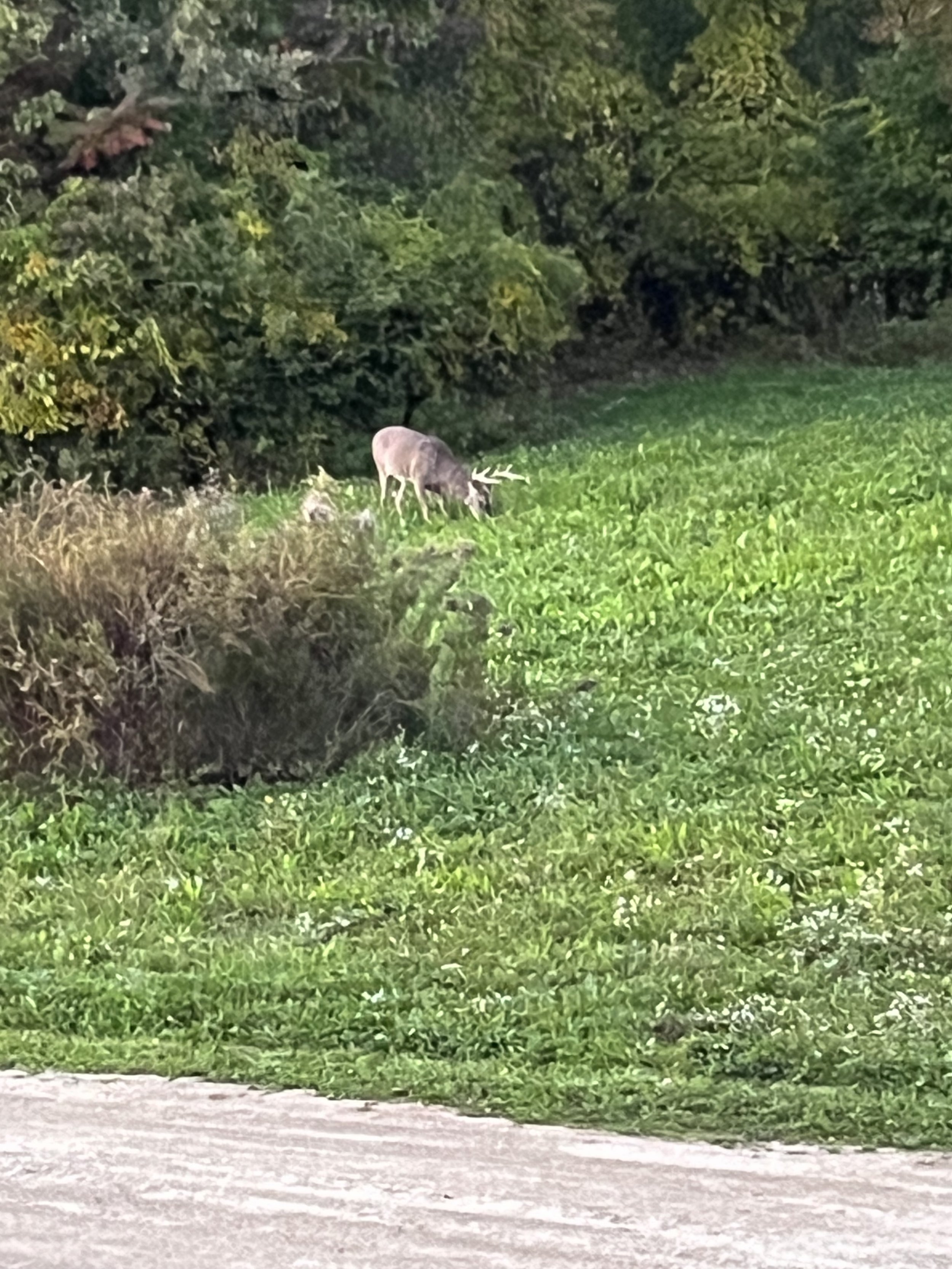2023 Land Management Case Study
It has been more than eight years since I first broke ground on this property and so much progress has been made! I’ve expanded from 61 acres to 108 acres. My food plots now total 10 acres, and they are in a variety of forages. I’ve converted the destination plots (half of Homestead and all of Central) to a rotation of spring soybeans and a fall mix, all incorporating regenerative agriculture techniques using a no-till grain drill. The deer population has grown dramatically, from just a few in 2014, to approximately 30 that now daily spend time on my land, and my harvest criteria has evolved from “if it’s brown it’s down,” to mature does only and a minimum buck age of 4 1/2 years. In the early years I would often spend the afternoon in a tree and not see a deer - in 2022 I hunted 26 days and had deer in front of me on 23 of those hunts.
The plan for 2023 looked to be more manageable than previous years, and it was a good thing because I had scheduled rotator cuff surgery for March and would be restricted to light duty for several months. I also planned to get a local contractor to improve most of my tractor road, something I’ve done myself in previous years, but I brought in a pro because the job is just too big. It will be fantastic to have a road that isn’t so bumpy.
There were a few trails to be cut that I did not get to in 2022, and most of them only needed moderate cutting. I planned to rework the northeast corner of the Homestead field to make the deer travel closer to the South Fence stand - there is always a lot of movement in that area, and the new field gap will put the deer within 30 yards from the stand.
Clover in the rye was a problem
When I notice a lot of deer coming and going in an area, but there aren’t any natural features that direct the deer movement, I always think about what I can do to get them to travel past a stand. My plan was to cut a new gap in the field and block the existing nearby gap with fallen trees. Then I would hinge-cut a barrier from the South Fence stand north to almost the property line to push deer travel past either the South Fence stand or a new stand I would locate in the corner of the property. The stand that’s farthest south will be moved back away from the Homestead field another 10 yards for better cover, and the North Fence stand will be removed.
I shot a buck from the Grove plot treestand, but this area is very difficult to hunt because deer come and go from all directions and can easily get downwind of the hunter. I planned to remove the treestand and replace it with a box blind - that should allow deer movement without the risk of getting busted. I also planned to clear a spot for a pop-up blind down the hill from Ridge Top and maybe work on the trails and barriers that funnel deer to this spot.
I wanted to improve the ground in front of the Ridge Top stand, as well as around the Swamp East stand just south of the barn. Both of these spots are quite rough - the Ridge Top is dry and rocky while the Swamp East is wet - so I wasn’t thinking I could put in a real food plot, but maybe just clear them out and seed them with a throw-and-grow product. Really just a spot with some browse that will draw deer a little out of their normal route.
Solution: cut the rye, spray the clover, drill in the soybeans
And, once again, I hoped to have the time to improve the bedding areas - I have deer bedding on my land and have a good idea of where those beds are, but I’m sure that I could create more bedding areas so I can put more deer in the hunting mix.
As mentioned above, and outlined in the 2022 update, my foray into regenerative farming started in 2022 when I used my new grain drill to plant soybeans in the spring and a blend of brassicas and grains in the fall. The soybeans are a fantastic crop for deer because the deer love them, they are nutritious, and they fix nitrogen into the soil. The fall blend completes the plan by drawing on that nitrogen to grow brassicas that feed and attract the deer throughout the hunting season, as well as winter rye and winter wheat that help the soil. In the spring, that crop of rye and wheat thrives, growing to almost five feet high and providing the material for a thick thatch that will cover the ground and keep weeds from competing with the next year’s soybeans. Of course, this is all in theory.
In May, when the ground was getting dry enough to work, I found that in the Central food plot and some of Homestead, I had a clover problem. These fields had been in clover for years so I had sprayed them in 2022 to kill them before drilling in the beans. I guess I hadn’t hit them hard enough because in these areas I had clover showing strong growth in among the tall rye and wheat. It didn’t look like I could plant soybeans, have it come up strong under the cover, and then expect the thatch to suppress the clover but let the beans grow through.
Crimping the rye to make a thick thatch layer
I decided to mow the rye and wheat down and then spray the exposed clover with a stronger glyphosate solution. Many people online recommend one or two quarts of glyph per acre but I now think that you need a full gallon per acre. Especially if you have an established clover plot you are trying to kill.
I wanted to expand my regenerative technique in the Homestead plot so I also cut and sprayed about two additional acres of clover. That would leave about 2 1/2 acres in Homestead that would be a mix of alfalfa and clover, as well as all of my small clover harvest plots that are scattered around the farm. If you plant all your food plots in annuals every year you are not diversified against a drought. Plus it’s a heck of a lot of work.
I planted soybeans on June 10th and 11th. I would have liked to plant a week or two earlier, but it was cold and rainy - you want an average soil temperature that is close to 70 degrees. The rain would be a problem all summer long. Some edges of Homestead were too wet to plant this year - the perfectionist in me hated that, but clearly I have enough forage in my plots to support several times the numbers of deer!
Moving a blind from Homestead to Grove with only one minor mishap
A couple weeks later the beans were coming up and it was time to crimp the rye. On the 3 1/2 acres that I had cut and sprayed there was nothing to crimp. But on the two acres that did not have a clover problem to the same degree, I had a good stand of winter rye (and winter wheat to a lesser degree) that I could crimp down over the emerging beans. The rye needs to be in the dough stage where the seed heads still have liquid you can squeeze out - that’s the best time to crimp. I ran the RTP Goliath crimper over the rye on June 29th, and as the stalks are knocked down the fins create crimps in the stalks that kill the plant. It doesn’t seem to bother the small bean plants much, and I hoped the clover would be covered over by the thatch and killed.
Well, the thatch helped, but I still had a clover problem in mid-July … what to do? Hey, these are Roundup Ready soybeans! Meaning that they are resistant to glyphosate! So I sprayed again! Three-times-the-charm … at least for this year.
With the spring planting under control, I could move on to my projects. The Redneck box blind that I had in the far western corner of Homestead was never a great spot to hunt - I didn’t have the deer traffic that I saw from the blind just 100 yards away - so I decided to move that blind over to the Grove plot. My friend Bruce from New Hampshire came over to help and we managed to break only one of the legs. Redneck has very reasonably priced replacement parts so I had it quickly fixed and was able to finish the job solo. The new spot solves the problem of deer getting downwind from the treestand that was in that area.
Hunting all day during the rut - yes, a urinal!
I reworked the area around the northeast corner of Homestead by cutting a new gap, hinge-cutting a barrier to force the deer to travel past a stand on the south end of the barrier and a new stand I located on the north end of that barrier. That area is in good shape but I still need to improve the path to the South Fence stand and clear better shooting lanes around the new Corner stand - I was in that stand later last year during the rut when a buck passed to the east without giving me a shot.
I relocated the creek stand that is down in the woods to the west of Homestead and the South Entrance. To keep the deer within shooting distance of the stand I hinge-cut a bunch of trees down by the creek. To make it easier for deer (and me) I made a trail from the South Entrance down to the creek, including digging part of it into the side of the steep slope. I was sneaking down that trail during the rut, only to spot a buck cruising past the new stand that was below me by the creek - I was just about an hour too late that day (but he was also a 3 1/2 year old that gets a free pass this year)!
Working on a deer bed. Still looking for the right formula.
I cleared a trail running north from Central to the swamp near the barn and made some hinge-cuts to direct deer movement. I had planned to clear an area for a popup blind on the east property line south of Ridge Top. I had shot a decent 3 1/2 year old 5-point two years ago from a climber on my neighbor’s property close to that spot, so I knew it was a good travel corridor during the rut. When I went to plan the area to clear I realized that it wasn’t going to work, so instead I found a good tree to hang a stand. I hunted it once in 2023, seeing a young buck cruising by, but the area still needs more barriers and trails to make it worth my time.
Ok, so here’s an interesting subject. During the rut when I want to be hunting all day long, it’s a hassle to bring multiple pee bottles, schlep them out of the woods, and remember to dump them. Years ago I pulled a prank on Bruce and Buddy. When I got back to camp I pulled out my pee bottle, held it up to the light saying, “it’s a little cloudy … I’ll run it through again,” before chugging down the apple juice. Well, to solve the problem (the pee bottles, not the cloudy issue) I found a bunch of urinals online and rigged them up in several of my stands and blinds. They drain into a garden hose that is buried in the ground. Sweet! I used them anytime I was out most of the day - mission accomplished! (We won’t talk about the holes the squirrels chewed in the hose at one stand and where that pee ended-up) Remember to hydrate!
Tractor road project took longer than planned
Less successful were the throw-and-grow micro food plots at Ridge Top and West Swamp. I cleared out the ground at Ridge Top with my tractor, making a smooth seed bed, and I spread Whitetaile Institue No-Plow. As to the spot over at the West Swamp stand, I had planned to put in the plot at the East Swamp stand just south of the barn, but that was too rough and wet so I shifted the idea to a spot in the northwest corner of my land. Neither spot did well. I think maybe I’ll just plant clover at Ridge Top in 2024, and I’m not sure I will do anything over by the West Swamp stand.
Another item on my to-do list that I didn’t really get-to was my plan to improve my bedding areas. I have been searching for years online for tips on improving deer bedding areas. I found videos and written narratives on bedding areas but not much of it really shows how to improve bedding in woods similar to mine. Much of my woods was clearcut about 15 years ago and is predominantly saplings - most of the information I have found concerns more mature woods. Never-the-less, I’ve done my homework and I’m ready to start experimenting. I made a couple beds, but I had a hard time in my test area making side cover that will give deer more privacy. I only made a few beds before I ran out of time. Hopefully I can do more in 2024.
One major objective for 2023 was to hire a contractor to improve the tractor road that runs through the middle of my land. Starting at the barn, the road runs south to the Central food plot, branches right and left, with the right branch running over to the Instep plot and the left branch going all the way past Grove and through Homestead to the South Entrance. Parts of it are wet and other parts are subject to erosion from the rain. The problem is that it is rough, and the bumps really limit how fast I can drive the tractor. It is almost a mile from the barn to the South Entrance, so speed is important.
El Chapo at 50 yards - one of his three visits
I got an estimate from my neighbor Dave in the spring but the weather was so wet all summer that he was still working on it well into the hunting season. It is better than it was, but I plan to buy a land plane to try to get the bumps out.
Dave was still trucking in fill and smoothing it in early September and mentioned that he had jumped a big buck a couple times in the food plot by the barn. My plan each year is to start hunting from stands that I can easily get in and out of with a low probability of spooking deer. The longer I can hunt without letting them know what I’m doing, the longer they will remain on their summer feeding pattern. During the first part of the season I will catch deer on-camera in the same places each evening, so there is a good chance of filling the freezer early. Does are usually more predictable because they are with a group that contains fawns and lactating does, each of which needs to eat as much as possible. Shooter bucks are not as quick to get on the feed in the evening, and there are far fewer of them. I have shot a doe right by the barn on opening day for the past couple of years.
September 9, 2023 was opening day and that afternoon I was in the box blind by the barn. It was another sweltering opening day hunt where I was dripping sweat until the sun started to fade and the temperature dropped. At 6:45 a nice buck walked into the plot from the west. He probably walked through the break in the woods that Dave made when he drove his excavator in from his land that abuts my land on the north side - for the past several years I have seen deer come into the barn plot from Dave’s land. This big guy was probably the buck that Dave had jumped a couple times recently.
A sapling I used to make a scrape
His body was big and he looked to be 4 1/2 years old, meeting my minimum age for a shooter buck. He settled down to feed in the northwest corner of the plot, but kept looking-up in my direction. I don’t think he ever got a glimpse of me in the blind, I was too careful for that and the windows are tinted. I think he just wanted to make sure that Dave wasn’t going to drive around the corner in his truck. I kept thinking that he would walk farther into the plot and give me a shot, but he didn’t, staying for 20 minutes and never getting closer than 50 yards.
A mock scrape branch holder
Ok, I now had a very rare close encounter with a homebody shooter buck, so my usual doe-in-the-freezer strategy went right out the window. Instead of shooting the next mature doe that came into range, my head was turned. What if I shot a doe and the resulting commotion spooked El Chapo? (I named him shorty due to the short tines on his rack, and because his thick body made his legs look short.) I needed to maintain my low-impact strategy, especially around the barn plot, so the noise and smell of recovering a deer, gutting it, and loading it in the truck would blow my cover.
I hunted the Barn plot a few more times without seeing El Chapo, so I started venturing farther into the middle of my land. I had several opportunities to take deer, but I kept thinking of the old buck that I really wanted, so I passed. I was still trying to be careful, especially around the barn, trying not to let deer know what I was up to. On the 29th of September I tried the barn plot again, and once again El Chapo came out at the end of the day. He stayed in the corner of the clover and I watched him for 43 minutes. Most of the time he was at 50 yards, and when he walked back to the north he was broadside at about 44. The whole time I was hoping he’d come closer. I practice at 40 yards all the time, and sometimes at 50, but a live animal at that distance is really a different matter. I can’t remember shooting a deer at more than 40 yards - the average in Maine is about 20, and last opening day the doe I shot was a bit more than 30.
Three days later I was back in the blind and El Chapo did the same thing. My closest shot would have been at 44 yards as he was walking out of the field. A walking deer at that distance presents an even greater problem - he is moving so I would need to make a noise to stop him, and then he’d be on-edge and likely to “jump the string,” which is the dropping motion deer make when they are loading their legs as they prepare to bound away. The drop happens in the split second after the arrow leaves the bow and before it reaches the deer. They may or may not jump the string, so a shot at an unrelaxed deer at that distance has a high chance of resulting in a miss, or a wounded deer. I did not take a shot.
This is the kind of trail cam image that keeps you hunting day after day!
For most of October I had El Chapo on my mind, but I didn’t hunt him exclusively. I hunted the Barn plot several times while also venturing to other spots, all the time still reticent to take a doe for the freezer. I never saw him again. On October 27th I was in the treestand that overlooks the west end of the Central plot. This was the third time I hunted that stand this season - the first time I saw 12 deer and the second time I saw at least 13. Both times I was using my Ozonics unit and had conclusive evidence that the unit was masking my odor when the wind swirled and a doe smelled something, stomping around with her nose in the air, but didn’t leave the field. During the first hunt a couple deer came over to investigate something - they were upwind but clearly heard a noise that they couldn’t identify. I realized that they were hearing the fan on the unit because it is on the bottom - I did a Google search later and learned to turn the unit upside down to eliminate that issue.
On the October 27th hunt the deer traffic in the field was much less - probably because this large food plot is in the middle of my land and there is no way to get out of there at the end of the hunt without jumping all the deer in the field. The pros you see on TV have someone drive an ATV in to pick them up - deer get used to vehicle traffic on the farm - but I didn’t have anyone to do that for me. Toward the end of the day a doe walked-in from the field to the right. She was on edge, and walked back to the right out of sight. A few minutes later she came back in and fed at 25 yards below me. I drew my bow and shot her just behind the shoulder. I found her about 100 yards away to the south. Finally … meat for the freezer!
I think they were on to me!
I hunted hard in 2023, spending more days in the field than I ever have. I saw a lot of deer, but there were more days than usual where I didn’t see any. It could be that I was just creating too much hunting pressure. I also was doing my tractor road improvement project right into the hunting season and that screwed up the northern half of the land. A few shooter bucks showed-up on camera during the rut and that kept me going, and always in my mind was that El Chapo might still be out there. It is always fun to watch bucks chase does and I had some of that, but I passed up the few opportunities I had to take another doe.
One evening after the sun had set and I was packing-up I noticed a light about 100 yards away on my neighbor’s land. It was a hunter getting down from their portable treestand. I was in the middle of my land and that hunter had been hunting within range of my Grove food plot. Maybe other hunters coming and going from deep in the woods - probably a half mile from any road - had also increased the perceived hunting pressure in the whole area.
Ahhh … my 2023 season in a nutshell!
In 2023 I tried various techniques for creating mock scrapes and really got results. I bought several plastic branch holders that I screwed into trees and made scrapes below them. In places where I could, I pounded a t-stake into the ground and ran a line to a bent-over a sapling so it would stick out into a food plot and I made a scrape beneath it. All were within range of a stand or blind. I had countless deer on-camera working the mock scrapes, and I watched deer on the scrapes when I was hunting. One afternoon my local 3 1/2 year old buck was working a mock scrape 100 yards away from me. I gave him a couple grunts, but he walked away - only to pop out of the woods 10 minutes later right below me. I will be expanding my mock scrape project in 2024.
39 Days hunting my land in 2023! That is by far more days than I have ever hunted this parcel and, because I saw deer just 23 of the days, it got to be a grind. That’s around 60% for just seeing deer, much less for getting a shot opportunity. The previous year I had seen deer 88% of the time. I hunted 13 more days in 2023, yet I saw deer the same number of days. 2023 wasn’t a bad year for me in the deer woods, just not as good as 2022. And, as usual, I learned a lot and I have a lot of ideas for next year!
To keep reading about my land management project, Click Here To Go Forward To 2024
To go back to the previous page, Click Here To Go Back To 2022.
